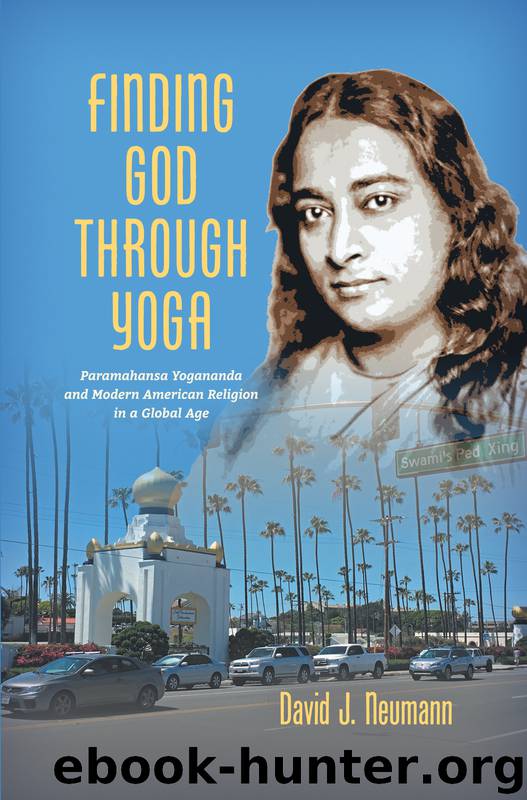Finding God Through Yoga by Neumann David J.;

Author:Neumann, David J.;
Language: eng
Format: epub
Publisher: University of North Carolina Press
Published: 2019-02-27T16:00:00+00:00
JESUS CHRIST AS PERFECT YOGI
Despite Yogananda’s long efforts on behalf of “the Hindu Bible,” it was not his most remarkable project as a leader of the global interfaith movement. That honor belongs instead to a regular column entitled The Second Coming of Christ. The series began in May 1932, ran through July 1942, and included 118 installments.117 A commentary on the life and teachings of Jesus as presented in the New Testament, this series clearly showed Yogananda’s deep interest in Jesus and his desire to draw connections between Christianity’s founder and yogic truth.
The Second Coming epitomized Yogananda’s version of Hindu-Christian syncretism, a thoroughly inclusivist effort to interpret Jesus and Christianity in light of universal Hindu truth. The title of the series already hinted at Yogananda’s legerdemain. In Christian parlance, the Second Coming traditionally identified the apocalyptic return of the resurrected Jesus to earth in the last days. Christian liberals had generally spiritualized Jesus’s return and often avoided Second Coming language, but fundamentalists, evangelicals, and Pentecostals generally continued to anticipate Christ’s literal return. But Yogananda meant something quite different by his use of the term: the yoga disciple’s full experience of self-realization, which he often termed Christ Consciousness. This was a “Second Coming” in which the believer no longer expected to encounter Jesus but aspired to eventually become Jesus. Through his commentary, Yogananda sought to reach a wide group of Americans, some only loosely tied to the Christian tradition but who retained a sense of reverence for Jesus and the Bible. He wanted to show that Yogoda was not antithetical to Christianity but rather the substance of which Christianity was merely the shadow. In seeking to understand Jesus in light of Hinduism, Yogananda was following the well-trod path taken by many modern Hindu thinkers. Contemporaries such as Vivekananda, Ramakrishna, Sarvepalli Radhakrishnan, and Sri Aurobindo devoted some attention to evaluating Christianity and Jesus. Though their approaches and the level of attention they devoted varied, they all basically distinguished between Jesus, whom they viewed favorably, and Christianity, which they uniformly criticized.118
A commentary on the Gospels was a bolder strategy than his exegesis of the Gītā. There, Yogananda delved deeply into an ancient Hindu text to explain esoteric truths. Here, he aggressively reinterpreted the core of the Christian Bible as Hindu truth. The closest parallel to The Second Coming is P. C. Mozoomdar’s 1883 The Oriental Christ, which follows Jesus’s career from baptism through the Crucifixion and Resurrection, drawing connections to Indian traditions. But Mozoomdar’s Jesus is still recognizable as the figure from the Gospels.119 How did Yogananda defend this hermeneutical move? He warned about the danger of literal biblical interpretation, which had “caused great havoc,” and instead advocated “intuitional perception of truth.”120 As one SRF monk, Brother Bernard, explained to an unconvinced newcomer, through meditation, Jesus is “becoming a living reality for people—a being with whom they can commune, instead of one whom they merely read about in the Bible. This was what Jesus meant when he said that he would come again.
Download
This site does not store any files on its server. We only index and link to content provided by other sites. Please contact the content providers to delete copyright contents if any and email us, we'll remove relevant links or contents immediately.
| Mid Atlantic | Midwest |
| New England | South |
| West | Kindle Edition |
| Large Print | Audible Audiobook |
| Audio CD | Board Book |
Kitchen confidential by Anthony Bourdain(2329)
Dry by Augusten Burroughs(1695)
I Know Why the Caged Bird Sings by Maya Angelou(1599)
Kitchen Confidential by Anthony Bourdain(1538)
KITCHEN CONFIDENTIAL Adventures in the Culinary Underbelly by Anthony Bourdain(1455)
A Child Called It by Dave Pelzer(1413)
I know why the caged bird sings by Maya Angelou(1379)
A Heartbreaking Work of Staggering Genius by Dave Eggers(1372)
Taken by J. C. Owens(1286)
all by Unknown Author(1247)
Zeitoun by Dave Eggers(1230)
Extraordinary, Ordinary People by Condoleezza Rice(1212)
A Stolen Life by Dugard Jaycee(1163)
House of Darkness House of Light by Andrea Perron(1160)
The Farm in the Green Mountains by Alice Herdan-Zuckmayer(1145)
Law Man by Shon Hopwood(1144)
The Big Sea by Langston Hughes(1095)
The Year of Yes by Maria Headley(1072)
Dewey: the Small-Town Library Cat Who Touched the World by Vicki Myron & Bret Witter(1017)
